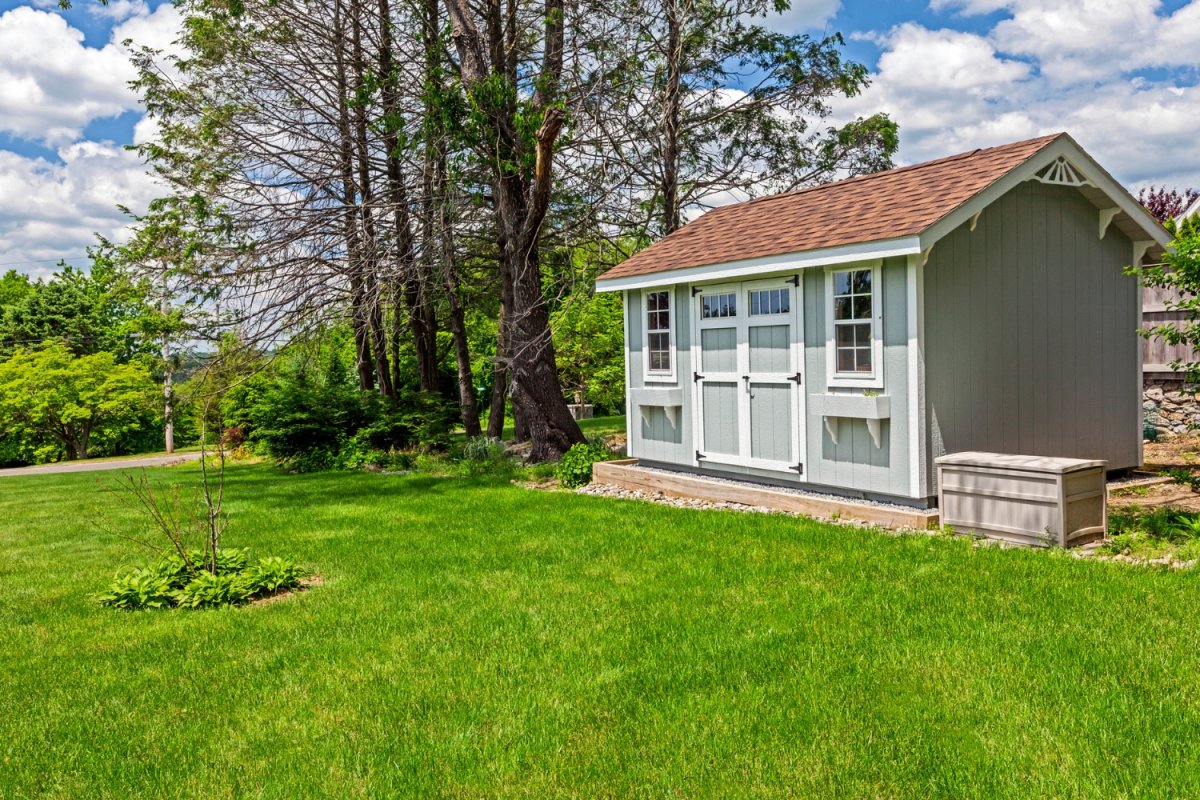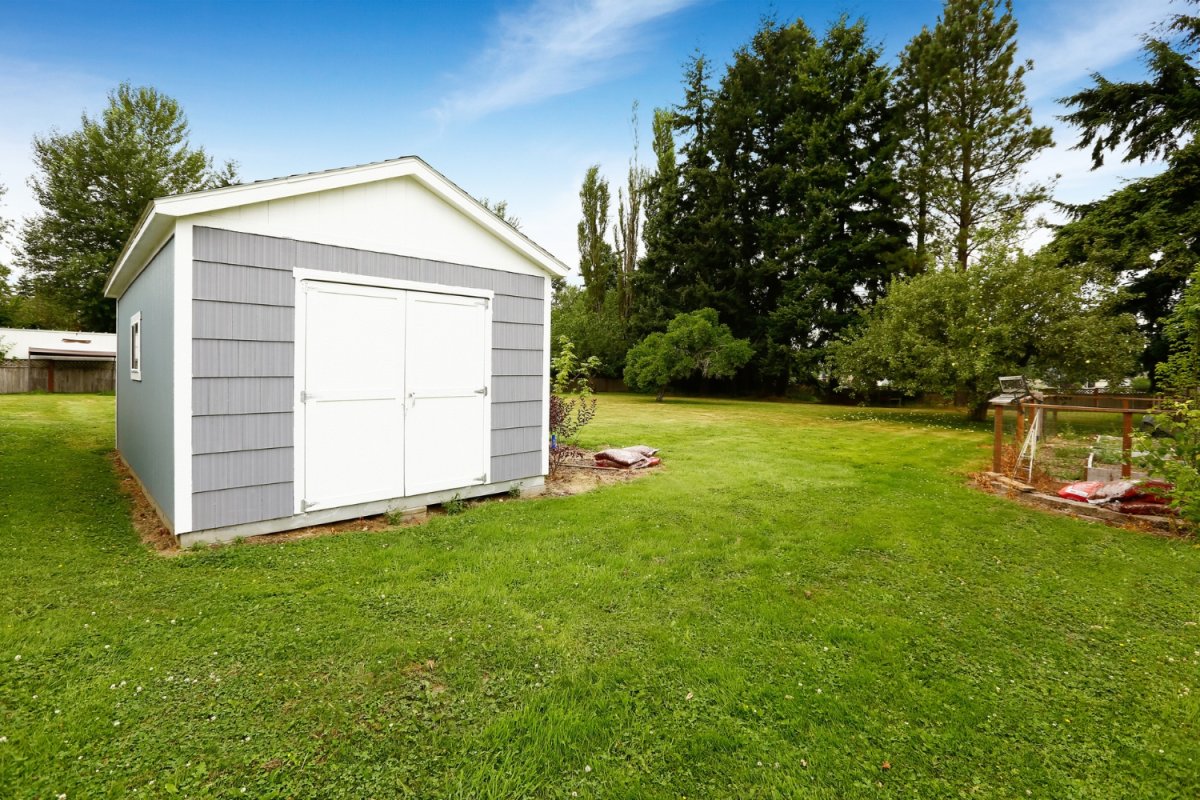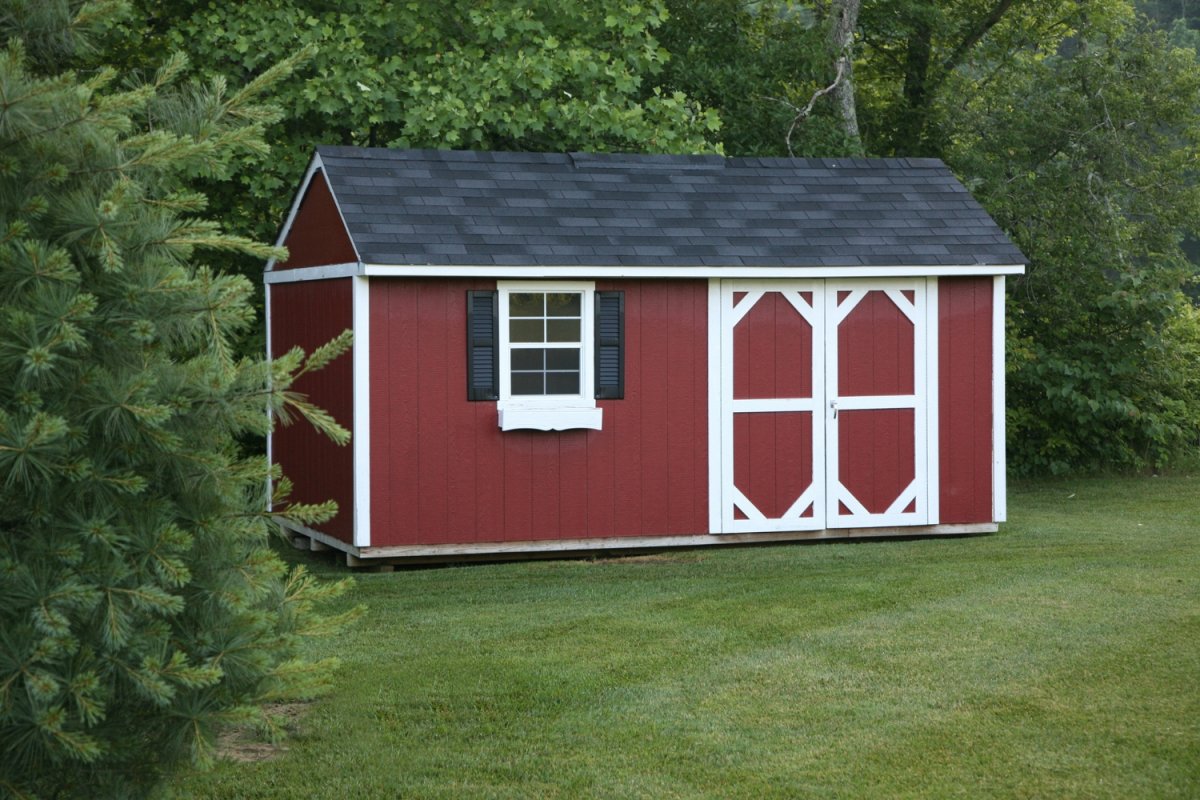

We may earn revenue from the products available on this page and participate in affiliate programs. Learn More ›
Highlights
- It typically costs between $200 and $1,000 to move a shed, with a national average cost of $500.
- The exact cost of moving a shed will vary depending on the shed size, the moving distance, and the cost of labor to move the shed to its new location.
- There are several reasons a homeowner may want to move a shed, including a home sale, a landscaping project that requires reorganizing the yard, and the replacement of an older shed with a new one.
- A homeowner may be able to DIY a basic shed move, but custom-built sheds and long-distance moves are best handled by a professional.
Moving an entire shed is no easy feat, whether a homeowner purchases a shed and needs to get it home or wants to move an existing shed to another location. According to Angi, the cost of moving a shed is between $200 and $1,000, with a national average of $500. Homeowners can expect to pay more for longer-distance moves or larger sheds, and the cost of labor will also factor into the total.
While it’s possible for a homeowner to rent a moving truck and move a shed themselves, professional portable building movers can help ensure a safer moving process. This guide breaks down all cost factors as well as explains the pros and cons of a DIY approach.

Key Cost Factors
The cost of shed moving can vary from the national average due to several factors, including the shed size, the scope of the move, and the cost of labor to move the shed. Although homeowners may think moving a shed seems pricey, relocation costs can often be lower than the cost to build a shed in a new location.
Shed Size
Sheds come in a range of types and sizes. Larger sheds,such as lean-to sheds, typically cost more to move than smaller sheds, since the shed size determines the size and type of moving truck needed. Generally, small sheds measure around 8 feet by 12 feet, medium sheds measure 10 feet by 10 feet, and large sheds measure 12 feet by 12 feet.
Moving Distance
The distance a shed is being moved affects the cost. A same-site transfer costs the least. Moving a shed to another part of the lawn may require shed-moving machinery, which will increase costs. If the shed is moving farther, most shed movers charge for moving services by distance. Moving companies charge $1 to $2 per mile, with mileage on larger trucks costing on the higher end. A local move, which is typically considered less than 100 miles, also costs much less than a long-distance move of more than 100 miles. Some companies may charge less per mile for moving a shed long-distance but charge more for additional gas and time.
Labor
Homeowners can DIY shed moving by renting a moving truck, but some jobs may require hiring a professional shed moving company. Shed movers cost between $910 and $2,530, and homeowners also have the option to drive the truck themselves and hire movers only to load and offload the truck. Whether a homeowner drives themselves or has the moving company drive, most local movers charge for their time, typically between $25 and $50 per hour.
Additional Costs and Considerations
When homeowners are budgeting for shed transport, it’s helpful for them to have information about additional costs and considerations to narrow down the total cost of the project. Homeowners will want to consider several additional factors, such as shed transportation, potential permits and fees, and any other additional items to be moved.
Transportation
Transportation costs depend on the rental company, the size of the vehicle, and the distance of the move. The average cost to rent a moving truck ranges from $20 to $3,500. For example, the cost of renting an 8-foot truck starts at $20 per day to move locally, while the cost of renting a 26-foot truck to move across the country can be $100 for each day. The average truck rental cost is $60 per day.
| Truck Size | Average Cost per Day |
| 10 feet to 12 feet | $20 to $30 |
| 14 feet to 20 feet | $30 to $80 |
| 22 feet to 26 feet | $40 to $130 |
| Over 26 feet | $40 to $150 |
Permits and Fees
States and local municipalities have different laws that may require permits to park a moving truck. These permits can cost between $10 and $80, depending on the area. Homeowners may also need a load permit. This type of permit allows drivers to have oversize and/or overweight vehicles carry large items, like a shed, on a public road.
“When going over-the-road, it is also important to research what the load rules, restrictions, and regulations are for your area, and when crossing through multiple counties, there may be several permits required,” explains Signe Kelly, co-owner at Kelly Moving & Rigging in Boise, Idaho. Permit costs vary by state, and loads must fit within the state’s allowable dimensions and weight. Additionally, oversize load permits may be valid only for a certain number of days, so homeowners will need to plan their shed moving accordingly. Homeowners may also want to visit the state’s permitting office or its website for more information.
| State | Load Permit Cost |
| Maryland | $30 |
| Ohio | $100 |
| Texas | $15 |
| Virginia | $500 |
Additional Items
If homeowners are moving additional items that may require a larger truck, special equipment, or professional storage shed movers, it could add to the total cost. Additionally, moving sheds involves more than simply picking them up and loading them onto a truck. For example, the homeowner or movers may need to disassemble the shed or other large items, remove ramps, or use additional skids, which are 4-foot by 4-foot wood timbers built into the base of the shed floor.
Types of Moves
How much it costs to move a shed will vary depending on the type of move. Generally, the farther the move, the more it will cost. On-site moving doesn’t require a truck and will therefore cost the least. Long-distance or extra-wide load moves will typically have a higher quote.
| Type of Move | Average Cost to Move a Shed |
| Onsite | $250 to $375 |
| Local | $400 to $500 |
| Long-distance | $4,000 |
| Extra-wide load | $6,000 to $7,500 |
Onsite Move
Moving a shed from one location to another on the same property may still require specialized tools, equipment, and time when homeowners are hiring storage building movers. To move a shed across a property, homeowners will spend around $100 on rollers such as PVC pipes, mounting planks, and other similar materials. A larger shed may require a trailer or forklift rental, which will increase the project’s cost. Professional movers will charge $250 to $375 to move an average-size shed to another location on the same property.
Local Move
Moving a shed a short distance, usually under 100 miles, will require a moving truck or trailer. Local movers typically charge between $25 and $50 per hour, and renting a truck could cost $1 to $2 per mile or between $20 and $150 per day, depending on the size of the truck. In total, moving a shed locally will cost between $400 and $500.
Long-Distance Move
Long-distance hauls, which are 100 miles or farther, can cost around $4,000. The precise cost will depend on the moving company, the size of the vehicle, and the total distance traveled.
Extra-Wide Load Move
An extra-wide load is a shipment that exceeds the state’s maximum length, width, height, and weight. The cost to move this type of shed falls between $6,000 and $7,500. Depending on the size of the shed, some states may require escort vehicles and special permits. Each state has its own rules and restrictions. This means an extra-wide load shipment through multiple states requires clearance from each one. An extra-wide long-distance move can add thousands of dollars to the project’s total.
Do I need to move my shed?
Homeowners will often question whether they really need to move their shed. “We get asked a lot if building a new shed wouldn’t be just as or more cost-effective than moving it, and the answer is that it just depends!” Kelly says. “Each building is a little different, and each move route is different, so it’s best to at least get an opinion from a professional, qualified mover and go from there.” There are several instances where a homeowner might consider moving their shed rather than buying or building a new one.
Home Sale
Homeowners may want to consider moving their shed when selling their home. However, the contract to sell the house typically includes all structures attached to the ground by default. Objects that cannot be freely moved are considered fixtures. Unless it is specified in the listing and contract that the shed is not remaining, then it must be included in the sale. The buyer may also say they don’t want to keep the shed, and the seller can choose to either take it with them when they move or get rid of it.
Landscaping Project
A landscaping project may require a homeowner to relocate their shed for aesthetic or practical reasons. For instance, the homeowner may be redesigning their garden layout, optimizing their yard space, or adding a new feature like a patio, walkway, or pool. Moving the shed may also be necessary for compliance or safety reasons, such as ensuring compliance with local zoning laws or moving it out of the way to avoid damage from heavy machinery. Finally, the homeowner may want to purchase one of the best storage sheds to add to their yard as part of a landscaping project so they have two sheds for extra space.
Shed Replacement
Another reason to move an existing shed is if the homeowner wants to replace it with one of the best sheds in their budget that offers more space and improved aesthetics. Homeowners can either disassemble the shed and get rid of it, sell it, or give it away to someone else. In this situation, it’s important to factor in shed removal costs $50 to $100 per hour. The cost to remove a shed also depends on the size of the shed, the difficulty in accessing the shed area, the condition and construction of the shed, the way it’s anchored, and the amount of debris that must be removed. Shed demolition equipment and large vehicles may also be necessary to dismantle and haul away the material.

DIY vs. Hiring a Professional
It’s entirely possible for a homeowner to move their own shed. “With the right equipment and experience, it is possible to DIY a shed move or hire a local handyman, especially if the building just needs to be moved a short distance,” Kelly says. In terms of cost, a DIY approach will depend on what equipment the homeowner already has on hand. On average, DIY shed relocation costs from $100 to $500 and takes about 48 hours to complete.
On the other hand, a professional knows how to move a shed and can do it safely and efficiently. Kelly recommends hiring a mover if the shed is custom-built, doesn’t have skids, or is larger than 12 feet by 20 feet by 10 feet. Shed movers can ensure a smooth and safe move and have the credentials and insurance to cover any accidents or damage. “Most shed movers and heavy structural movers are licensed and insured to handle any accidents that might occur while moving a structure, and this is one of the big considerations in hiring the professionals,” Kelly adds.
Professional shed movers will also know which permits are required for relocation. This is especially useful when the shed is being relocated across state lines. Moving an oversize or overweight vehicle load requires a permit for each state it travels through, and a professional mover can help coordinate pulling necessary permits. Homeowners will want to do their due diligence and get several quotes to find the best storage shed moving company for the job that fits their budget.
How to Save Money
Hiring professional movers can be costly, especially when homeowners are moving a shed long distances. Luckily, there are several ways to save money on the cost of moving a shed.
- Get multiple quotes. Before making a decision, homeowners are advised to get at least three quotes from the best moving companies, such as United Van Lines or American Van Lines. This will allow them to find a price that works within their budget.
- Sell the shed. Homeowners may want to consider selling the shed and having the buyer remove it from the property.
- Ask about discounts or package deals. Professional movers may offer discounts for off-season moves or for seniors, students, and military members. Movers may also offer package deals when moving multiple items.
- Be prepared. To help cut down on the hourly rate, homeowners will want to remove all items and disassemble the shed as much as possible before the movers arrive.
- DIY. Homeowners can save on costs by doing as much DIY as possible. It may be possible to do the entire job without the help of a mover with the right equipment and transportation.
Questions to Ask a Pro
Before hiring a shed moving company, homeowners will want to ask the right questions, such as the following, to avoid costly surprises.
- How long have you been in business?
- How much experience do you have with shed relocation?
- Do you have references?
- What types and sizes of sheds do you typically move?
- Do you have specialized equipment for moving sheds?
- Is the estimate free?
- What’s included in the estimate?
- Does the estimate include permit fees?
- Are you licensed and insured?
- Is your crew licensed and insured?
- How is your crew trained with regard to safety?
- What is your timeline for the project?
- How do you handle obstacles like trees, fences, or other structures during the move?
- How will you protect my yard?
- Who will be my point of contact?
- Who will supervise the project?
- How long will the moving process take?
- Do you offer any guarantees or warranties?
- Are there any factors that might affect the cost of moving my shed?
- Will you level the shed at its new location?
- What payment methods do you accept?
- Do I need to make any preparations beforehand?
FAQs
Before embarking on this project, homeowners will need to fully understand the entire process of moving a shed. They can review the most frequently asked questions about moving a shed to familiarize themselves with the process.
Moving a shed can be easy if it is a short distance and the right tools, materials, and transportation are available. With help, it’s possible to lift a small shed and move it to a different location on the same property or into the bed of a truck for transportation. A larger shed may require a tilt trailer, flatbed truck, forklift, or crane.
It’s possible to move a shed without dismantling it. First, measure the structure to determine how much room it will take up while being transported. If it can fit on a truck or trailer, it likely won’t need to be dismantled.
How much a shed weighs depends on its size and materials. A 12-foot by 12-foot wooden shed weighs around 2,500 pounds, while the same-size shed made out of metal weighs around 700 pounds.
Homeowners can put a shed on wheels to simplify the moving process. However, it may depend on the shed’s size and weight, its foundation, the design, and any connected utilities.
Angi, Glick Woodworks LLC, Airtasker
